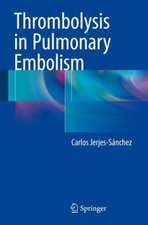Emerging Pathologies in Cardiology: Proceedings of the Mediterranean Cardiology Meeting 2005
Editat de M.M. Guliziaen Limba Engleză Hardback – 13 apr 2005
Preț: 1108.35 lei
Preț vechi: 1166.69 lei
-5% Nou
Puncte Express: 1663
Preț estimativ în valută:
212.11€ • 220.63$ • 175.11£
212.11€ • 220.63$ • 175.11£
Carte tipărită la comandă
Livrare economică 15-29 aprilie
Preluare comenzi: 021 569.72.76
Specificații
ISBN-13: 9788847003118
ISBN-10: 8847003113
Pagini: 407
Ilustrații: XV, 407 p.
Greutate: 0.77 kg
Ediția:2005
Editura: Springer
Colecția Springer
Locul publicării:Milano, Italy
ISBN-10: 8847003113
Pagini: 407
Ilustrații: XV, 407 p.
Greutate: 0.77 kg
Ediția:2005
Editura: Springer
Colecția Springer
Locul publicării:Milano, Italy
Public țintă
Professional/practitionerDescriere
Clinical practice is evolving at a rapid pace,nowhere more so than in the field of cardiology.Acute Coronary Syndromes, Sudden Cardiac Death, Heart Failure, Atrial Fibrillation,Syncope,and Prevention of Global Cardiovascular Risk are the main Emerging Pathologies to which many investigators are addressing their researches. Less than 10 years ago, some of them were considered of relevance only to internists, and some others as a common benign arrhythmia or an ineluctable illness. Today, their prevalence amongst the population represents one of the major public health problems at the beginning of the third millen- um. The need to have a state of the art overview of the epidemiology,physiopat- logical and electrogenetic mechanisms, diagnosis, pharmacological or electrical treatment,prognosis,patient management in and out of hospital,organisational and economical implications of these emerging pathologies and the success of the previous edition inspired us to organise the second edition of this biannual International Meeting. This book contains the Proceedings of the Mediterranean Cardiology Meeting held in Taormina, Italy, 7–9 April 2005. Like the previous volume, it boasts the participation of many nationally and internationally renowned spe- ers in the field of clinical and interventional cardiology who will interact actively with the delegates.
Cuprins
Emerging Concepts in the Assessment of Acute Coronary Syndromes and Global Cardiovascular Risk.- Pathogenetic and Immunological Paradigm of Atherosclerotic Plaque.- Are a Single Measurement of Troponin-I and C-Reactive Protein of Clinical Significance in Patients with Acute Coronary Syndromes?.- New Strategies for Treating Myocardial Infarctions.- Tirofiban and NSTE-ACS: The Current Perspective.- Acute Coronary Syndromes and Diabetes: How Much Can We Intervene?.- Spinal Cord Stimulation in Refractory Coronary Artery Disease: The Last Resort?.- Guidelines for Antihypertensive Treatment: The Debate on the Choice of Antihypertensive Drugs.- Aspirin and Cardiovascular Prevention in the Guidelines and in the Real World.- Serial Changes in Left Ventricular Mass in Hypertension: Prognostic Impact.- Atrial Fibrillation: The Actual Clinical Approach.- New Approach in the Prevention of Atrial Fibrillation: Role of Angiotensin II Antagonists.- Role of Echocardiography in the Management of Atrial Fibrillation Patients.- Pharmacological Prevention of Arrhythmic Recurrences.- Timing and Typology of Cardio-Embolic Prevention in Patients with Atrial Fibrillation.- Non-Electric Treatment of Atrial Fibrillation: When Not to Treat?.- The Role of Imaging in Catheter Ablation of Atrial Fibrillation.- Atypical Atrial Flutter.- Advances in Surgical Treatment of Atrial Fibrillation.- Cardiac Resynchronisation Therapy: New Therapeutic and Diagnostic Perspectives in Heart Failure Management.- Guidelines for the Management of Patients with Heart Failure.- How to Detect Dyssynchrony and How to Correct It.- Advancements in ‘Over-the-Wire” Versus Stylet-Guided Left Ventricular Leads.- Assessment of Diastolic Function in Heart Failure and Atrial Fibrillation.- Is CRT Useful in Patients with Atrial Fibrillation?.- Future New Indications for CRT: Which Patients Might Benefit?.- Economic Benefits of Cardiac Resynchronisation Therapy.- Cost-Effectiveness of Cardiac Resynchronisation Therapy in Heart Failure Patients.- Managing Sudden Death: The Selection of Patients, Drugs and Devices.- Guidelines for the Prevention of Sudden Cardiac Death: Filling the Gap.- Management of Cardiac Arrhythmias in Post-PCI Patients.- Anti-tachycardia Pacing for Termination of Rapid Ventricular Tachycardia in Patients with Implantable Cardioverter-Defibrillators. The PITAGORA ICD Trial.- MADIT II/SCD-HeFT Results: Have They Already Achieved an Impact in Europe?.- Short QT: The Novel Gaita Syndrome?.- Remote Patient Management of ICD: Of What Value Is It in Clinical Practice?.- BLSD Prevention of Sudden Death: What Is the Difference Between Lay People and Medical Professionals?.- ACC/ESC Recommendations for the Clinical Management of Hypertrophic Cardiomyopathy: A Practical Perspective.- Risk Identification in Arrhythmic Athletes with Fatal or Resuscitated Cardiac Arrest.- New Trends in Physiological Pacing and Optimal Pacing Sites.- Physiological Pacing: Perspective.- Optimal Pacing Site in the Atrium and the Ventricle for Patients with Sino-Atrial Disease.- Role of His-Bundle Pacing: Reliability and Potential to Avoid Ventricular Dyssynchrony.- Pacemaker for Vasovagal Syncope: Good for the Few.- Quality of Life of Patients with an Atrial Defibrillator: Does Optimal Programming Achieve the Goal of Maintaining Sinus Rhythm as Well as Improve Quality of Life?.- Haemodynamic Sensing in the Control of Pacing Function.- Haemodynamic Assessment by Transvalvular Impedance Recording.- Rate-Responsive Pacing Controlled by Transvalvular Impedance: Preliminary Clinical Experience.- Initial Experience of Implanted Pacemakers with Intracardiac Haemodynamic Sensor: Evaluation of Sensor Safety.- Transvalvular Impedance in the Autoregulation of a Cardiac Pacemaker.- Syncope: Practical Issues of Diagnosis and Treatment.- Guidelines for the Management of Syncope.- Role of Anamnesis: Is It a Complete Tool?.- Is There Still a Role for Drug Therapy in Vasovagal Syncope?.- When Do We Need a Permanent Pacemaker in Neuromediated Syncope?.- Latest Technologies In Cardiovascular Imaging: An Update for the Clinical Cardiologist.- CT Coronary Angiography with 16-Row Multi-slice Scanner: Do We Still Need Conventional Coronary Angiography?.- Multislice CT for the Study of Aortic Aneurysms.- MRI in the Diagnosis of Right Ventricular Dysplasia.
Textul de pe ultima copertă
The book aims to give the most up-to-date information about the epidemiology, the pathophysiology, the diagnosis and the new treatments of the Emerging Pathologies in Cardiology. It presents the state of the art on Acute Coronary Syndromes, Sudden Cardiac Death, Heart Failure, Atrial Fibrillation, Syncope and Prevention of Global Cardiovascular Risk which are some of the emerging pathologies urging investigators to develop many and more sophisticated pharmacological, electrical or mechanical therapies. The volume chapters are written by world-renowned leading experts in these fields, and present a detailed analysis of the most recent developments in the treatment of the above mentioned cardiac pathologies.






